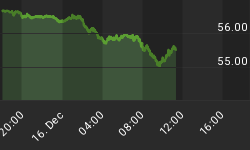Below is an excerpt from a commentary posted at www.speculative-investor.com on 28th June 2015. Excerpts from our newsletters and other comments on the markets can be read at our blog: http://tsi-blog.com/
Inflation expectations bottomed in January of this year, or, to put it another way, deflation expectations peaked in January of this year. The question is: did the January reversal mark a 1-2 quarter shift or a much longer-term shift? We think it will prove to be the latter, although we hasten to point out that we are not anticipating a dramatic increase in inflation fear within the next year -- just the dawning of a general perception that more "inflation" lies ahead.
Evidence that US inflation expectations bottomed in January of this year is contained in the performance of the US yield curve, as indicated on the following chart by the 10yr-2yr yield spread. The chart shows that the 10-year yield started rising relative to the 2-year yield near the end of January.

There are two possible causes of a significant rise in the 10yr-2yr yield spread. The first is increasing inflation expectations, in which case the rising yield spread will be driven by increasing long-term interest rates or by long-term interest rates holding up relatively well while the central bank forces short-term rates downward. This happens because long-term interest rates are influenced by inflation expectations to a much greater extent than short-term interest rates. The second is the unwinding of carry trades and a general shift away from risk, in which case the rising yield spread will be driven by decreasing short-term interest rates.
As an aside, a rising yield-spread (steepening yield curve) is bullish for gold regardless of whether it is driven by rising long-term interest rates (increasing inflation expectations) or falling short-term interest rates (a general shift towards safety). However, its bullish influence can be offset by other fundamental drivers, as was the case in 2013 and over the past few months.
We know that the rise in the US 10yr-2yr yield spread from its January-2015 bottom was caused by increasing inflation expectations because it was driven by rising long-term interest rates.
The message of the US yield curve is echoed by the "Expected CPI" (the difference between the yield on a standard 10-year T-Note and the yield on a 10-year TIPS), which also indicates that inflation expectations have risen markedly over the past 5 months. As evidenced by the following chart, the rate of "price inflation" that the market expects the US government to report over the years ahead began to trend upward in January after falling sharply over the preceding 6 months.

Although it is far from a foregone conclusion, the January-2015 reversal in the expected rate of "price inflation" probably marked the start of a trend that will remain in force for more than 12 months. This is because the two main drivers of the preceding decline in inflation expectations appear to have been eliminated.
The first of these drivers was the (irrational) fear that the ECB and Europe's banks would be unable to create enough new money and credit to prevent the euro-zone from experiencing sustained "price deflation". The sharp rise over the past several months in the euro-zone's monetary inflation rate to near an 8-year high (see chart below) has rendered this fear obsolete. The second of these drivers was the view that the oil market's downward trend would continue well beyond the first quarter of this year, with the price eventually falling to the $20s or even lower. While this view has not yet been completely disproved, it is very much a long-shot due to the oil market having traced out a pattern that over the past 30 years has invariably marked a bottom of at least intermediate-term significance.

It's certainly possible that the nascent upward trend in inflation expectations will be brought to a premature end by a steep decline in the stock market, but this is not the most likely outcome. The reason is that even if an equity bear market were to begin this year, a price decline of sufficient magnitude to create a deflation scare probably wouldn't happen until next year. For example, the previous equity bear market got underway during the second half of 2007, but a deflation scare didn't materialise until the third quarter of 2008.
In summary, inflation expectations have turned the corner and the new trend will be sustained through the remainder of this year and well into next year. That's our current view, which is, of course, subject to change if conflicting facts present themselves.
Regular financial market forecasts and analyses are provided at our web site: http://www.speculative-investor.com/new/index.html. Also, samples of our work (excerpts from our regular commentaries) and additional thoughts on the financial markets (and other stuff) are provided at our blog: http://tsi-blog.com/
















